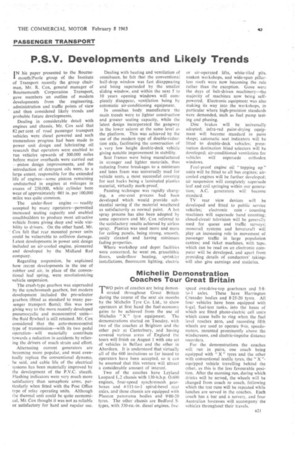P.S.V. Developments and Likely Trends
Page 47

If you've noticed an error in this article please click here to report it so we can fix it.
IN his paper presented to the Bourne' mouth/Poole group of the Institute of Transport recently the group chairman, Mr. R. Cox, general manager of Bournemouth Corporation Transport, gave members an outline of modern developments from the engineering, administration and traffic points of view and then considered likely trends and probable future developments.
Dealing in considerable detail with engines and chassis, Mr. Cox said that 82.per cent of road passenger transport vehicles were diesel powered and such tremendous progress had been made in power unit design and lubricating oil research that operators were enabled to run vehicles upwards of 300,000 miles before major overhauls were carried out —piston design improvements, and the introduction of detergent oils were, to a large extent, responsible for the extended life of engines—some pistons remaining undisturbed in engines at mileages in excess of 250,000, while cylinder bore wear of approximately .001 in. per 100,000 miles was quite common.
The under-floor engine — readily accepted by many operators—permitted increased seating capacity and enabled coachbuilders to produce most attractive vehicle fronts giving deep and wide visibility to drivers. On the other hand, Mr. Cox felt that rear mounted power units could be vulnerable to collision damage. Latest developments in power unit design included an air-cooled engine, pioneered and developed by the Midland Red company.
Regarding suspension, he explained how recent developments in the use of rubber and air, in place of the conventional leaf spring, were revolutionizing vehicle suspension.
The crash-type gearbox was superseded by the synchromesh gearbox, but modern development included the pre-selector gearbox (fitted as standard to many passenger transport fleets); this was now giving way to the more recently developed pneumocyclic and monocontrol units— the fluid flywheel is still retained, Mr. Cox considered that the auto-rnonocontrol type of transmission—with its two pedal operation-will materially contribute towards a reduction in accidents by relieving the drivers of much strain and effort.
Alternating current generators are becoming more popular, and must eventually replace the conventional dynamo, he said, and cable life of the electrical systems has been materially improved by the development of the P.V.C. sheath. Flashing indicators were very much more satisfactory than semaphore arms, particularly when fitted with the Post Office type of relay operating units. Although the thermal unit could be quite economical, Mr. Cox thought it was not as reliable or satisfactory for hard and rogular use.
Dealing with heating and ventilation of omnibuses, he felt that the conventional half-drop window was fast disappearing and being superseded by the smaller sliding window, and within the next 5 to 10 years opening windows will completely disappear, ventilation being by automatic air-conditioning equipment.
In omnibus body manufacture the main trends were to lighter construction and greater seating capacity, while the Latest design incorporated the gangway in the lower saloon at the same level as the platform. This was achieved by the use of the modern type of double-reduction axle, facilitating the construction of a very low height double-deck vehicle giving notable improvement in stability.
Seat frames were being manufactured in stronger and lighter materials, thus reducing frame breakages to a minimum and latex foam was universally used for vehicle seats, a most successful covering for seat backs being a laminated plastics material, virtually mark-proof.
Painting technique was rapidly changing, a one-coat process had been developed which would provide substantial saving if the material weathered as satisfactorily as normal paint. A hot spray process has also been adopted by some operators and Mr. Cox referred to the satisfactory results achieved by airless spray. Plastics was used more and more for ceiling panels, being strong, smooth. easily cleaned and having minimum fading properties.
Where workshop and depot facilities were concerned, he went on, granolithic floors, underfloor heating, sprinkler installations, fluorescent lighting, electric or air-operated lifts, white-tiled pits, sunken workshops, and wide-span pillarless roofs were now becoming the rule rather than the exception. Gone were the days of belt-driven machinery—the majority of machines now being selfpowered. Electronic equipment was also making its way into the workshops, in particular where high-precision standards were demanded, such as fuel pump testing and phasing.
Disc brakes will be universally adopted; infra-red paint-drying equipment will become standard in paint shops; automatic seat indicators will be fitted to double-deck vehicles; pressbutton destination blind selectors will be developed; air-conditioned ventilation for vehicles will supersede orthodox windows.
Fool-proof engine oil "topping up" units will be fitted to all bus engines; aircooled engines will be further developed; air suspension will completely supersede leaf and coil springing within our generation; A.C. generators will become standard.
TV rear view devices will be developed and fitted to public service
vehicles; electronic coin counting machines will supersede hand counting; closed-circuit television will be generally used for queue and traffic surveys; monorail systems and hovercraft will play an increasing role in movement of passenger traffic in large population centres; and ticket machines, with tape, which can be read on an electronic computer will be developed, and apart from providing details of conductors' takings will also give earnings and statistics.




















































































































